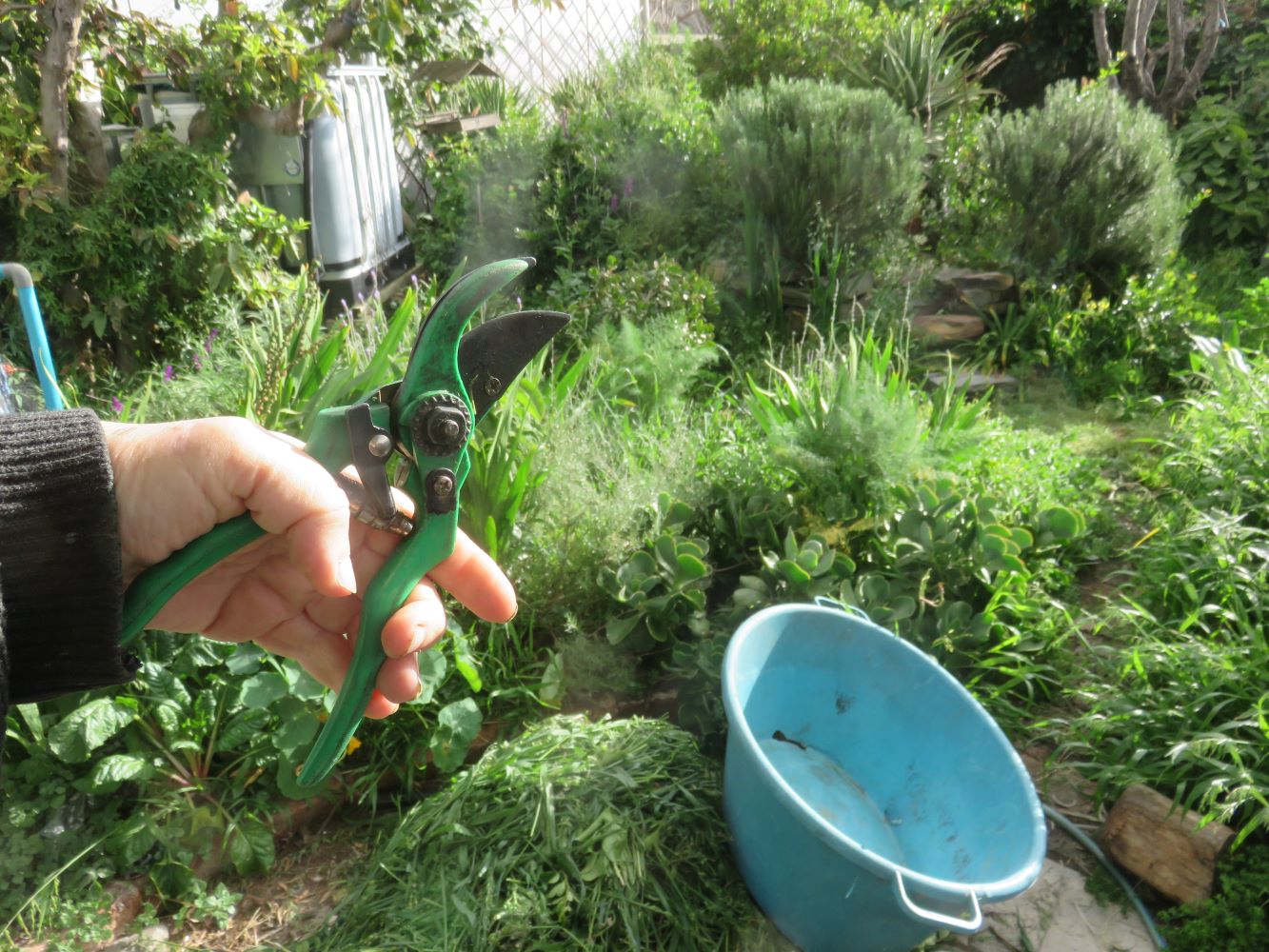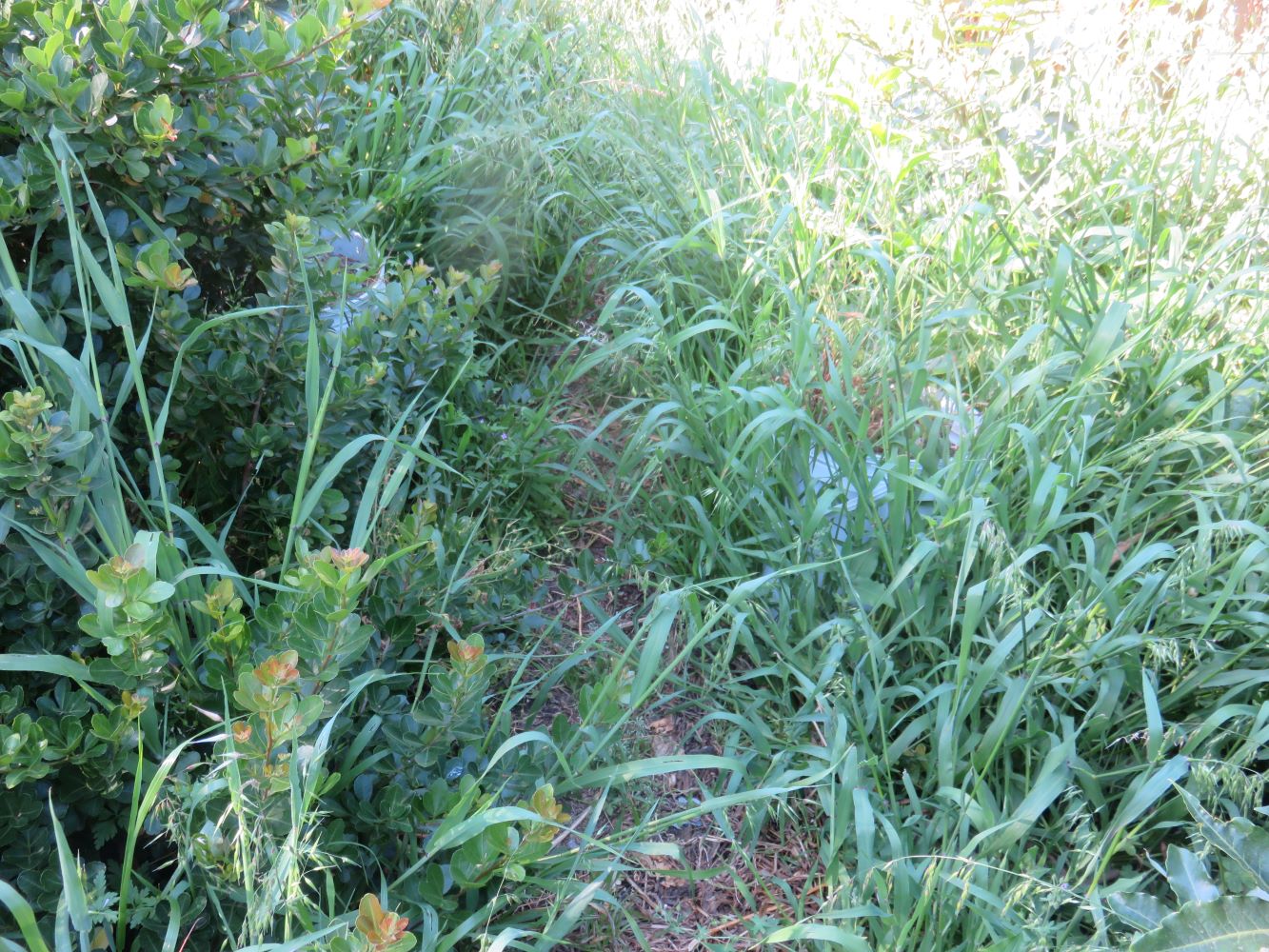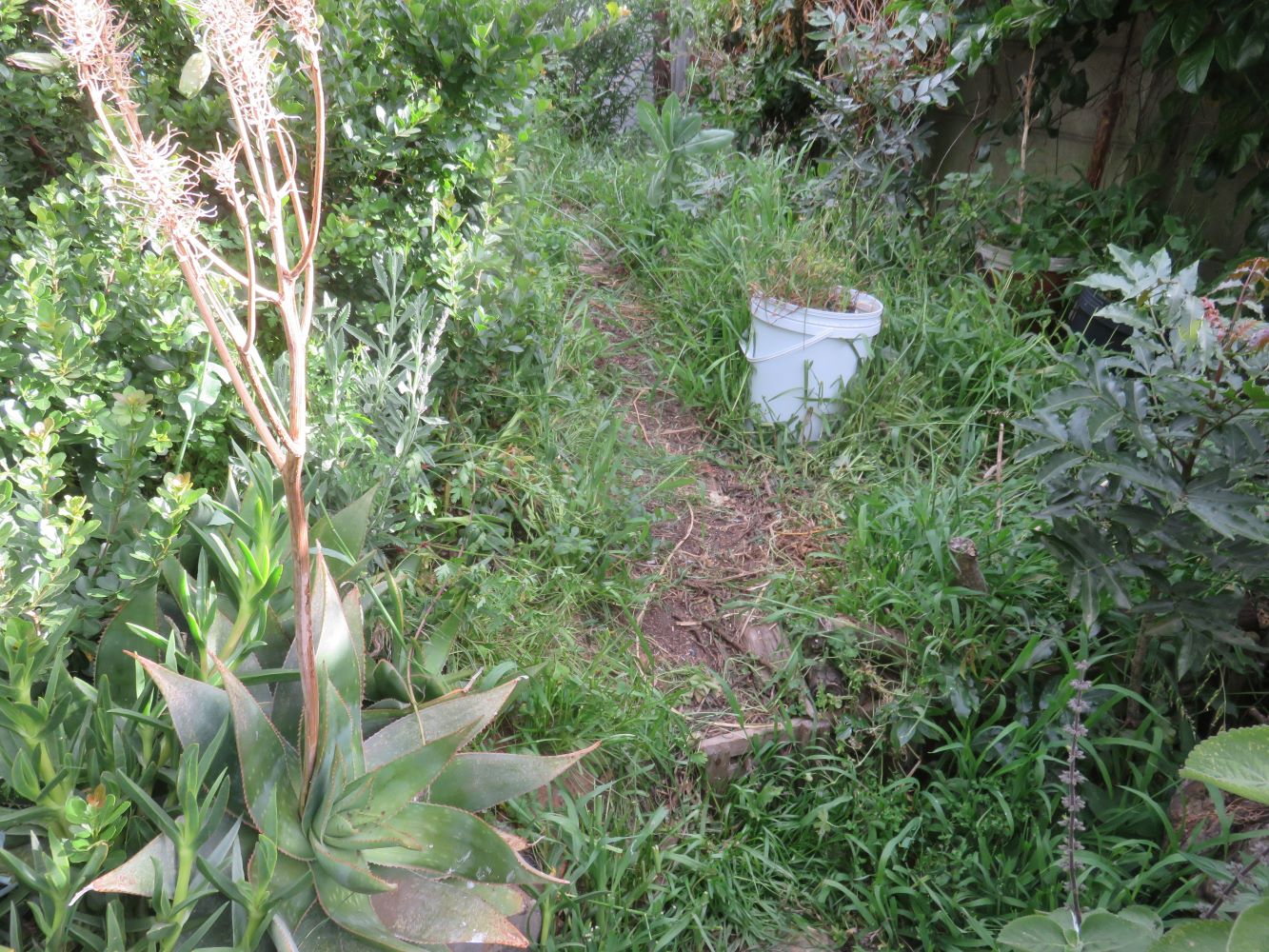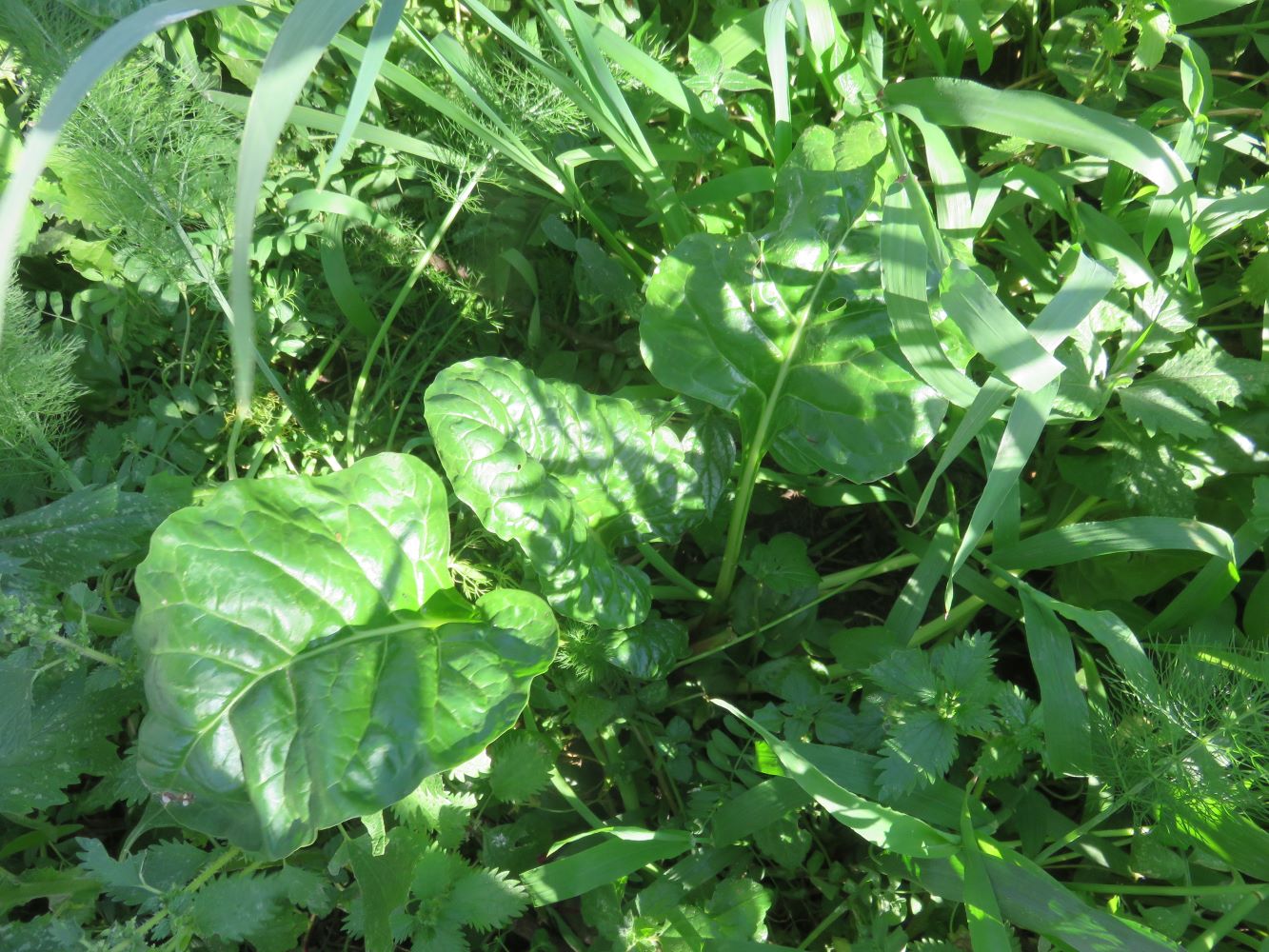Dear Reader, in this age of AI created content, please support with your goodwill someone who works harder to provide the human-made. Sign up at the top of the lefthand column or bottom of this page. You will receive my hand illustrated monthly newsletter RESTORE NATURE and access to the biodiversity garden design course as I write...and nothing else, I respect your time. I am also removing the advertizing as best I can as its become intrusive inappropriate and pays me nothing.
Encourage biodiversity in the garden with clipping
Oct 8, 2020.
 Keep biodiversity in the garden with clippers and container.
Keep biodiversity in the garden with clippers and container.Regenerative gardening activity
4
Diversity brings stability and resilience to a system.
This post explains how you can keep tweaking the plant diversity in your garden beds. I will explain in other posts how to create the diversity with planting and seeds that support insects, and creating biodiversity in the garden in other ways.
I will not use the word weeding, on purpose.
It is an anathema in regenerative gardening. The way it is
conventionally practiced is to tear plants out by the roots, gather them
up and take them away and leave the soil naked. Permaculture's chop 'n
drop technique is better, but the way I practice regenerative gardening
takes the damage limitation a few steps further.
The soil microbiome is most concentrated in the zone around the plant root, wrapping it intimately like a protective shield. Ripping up the roots destroys this life and takes away the nourishment for any replacement. Leaving the soil naked kills the surface microbiome within hours.
Instead one can practice diversity maintenance. I need a new word so that there is no confusion, because it is totally unlike... (shhh self... I said it was now taboo).
A wise old woman and master gardener told me once, "Leave the weeds until you have something better to replace them that will cover the soil". Another master gardener in Cape Town told me the same, adding "otherwise you create a problem for yourself".
So how do we practice diversity maintenance ?
1) We need to leave thriving plants and living roots in the soil for as long as is possible, and if there is nothing else you have to plant out, just leave the so called weeds. Identify all your 'weeds'. You may find they are actually vegetables you can use to diversify your diet. This will diversify your own gut microbiome, provide loads of 'organic' greens, and the phytochemicals in them. All of these can increase your health and prolong life.
2) Even when you have veggies, always keep some weeds, but keep them in check. Its more work than a conventional vegetable garden at this stage, its true. Starting the regeneration motor is not neglect, though it may look like it. The weeds you leave add to diversity and that means a more diverse, more resilient soil microbiome. They also provide cover and shade and root sugars. In the end, magic begins to happen, stability begins to manifest, and you spend a lot less time on diversity maintenance. It begins to maintain itself.
3) If grass has taken over, clip it back, like mowing it but leaving it quite long. The clipping stimulates regrowth and photosynthesis. On a large property you could use a long handled scythe. C4 grasses are photosynthesis powerhouses, enriching your soil.
4) If a bed is filled with other unwanted plants and not vegetables, leave them all in the ground until you have vegetables.
5)
If you have vegetables in the bed, clip back any other plants you do
not want. Just clip enough so that your useful plants have space for
their leaves and light. In nature plants grow tightly close together not
spaced like in a classic vegetable bed. Believe me, plants love each
other as a rule. Leave a few weeds of as many different kinds as
possible in the bed with the vegetables.
6) Only remove rampant invaders that push aside other plants. The point is to spot mono cultures developing and diversify them. Thin these plants a lot. Cut them back near the ground. If they spread by roots and it is possible pull them out one stalk at a time, do so, so that you do not pull up a great big root mass and disturb the soil.
7) As you thin the foliage in the bed, naked soil may be exposed. Cover it IMMEDIATELY with some of the clipped material.
8) You can leave all the clipped material in situ, if there is space between the plants or around them. You don't want to put it on top of them, and block off the light and photosynthesis. Otherwise put them in a container and compost them with your humanure or other compostables.
 before clipping before clipping |
 after clipping after clipping |
 An area of the garden with self maintaining biodiversity
An area of the garden with self maintaining biodiversity------
home page for links to all my topics on regenerative and restorative gardening techniques
------
greenidiom's regenerative gardening blog
------
------
Restore Nature Newsletter
I've been writing for four years now and I would love to hear from you
Please let me know if you have any questions, comments or stories to share on gardening, permaculture, regenerative agriculture, food forests, natural gardening, do nothing gardening, observations about pests and diseases, foraging, dealing with and using weeds constructively, composting and going offgrid.
SEARCH
Order the Kindle E-book for the SPECIAL PRICE of only
Prices valid till 30.09.2023
Recent Articles
-
garden for life is a blog about saving the earth one garden at a time
Apr 18, 25 01:18 PM
The garden for life blog has short articles on gardening for biodiversity with native plants and regenerating soil for climate amelioration and nutritious food -
Cape Flats Sand Fynbos, Cape Town's most endangered native vegetation!
Apr 18, 25 10:36 AM
Cape Flats Sand Fynbos, a vegetation type found in the super diverse Cape Fynbos region is threatened by Cape Town's urban development and invasive alien plants -
Geography Research Task
Jan 31, 25 11:37 PM
To whom it may concern My name is Tanyaradzwa Madziwa and I am a matric student at Springfield Convent School. As part of our geography syllabus for this
"How to start a profitable worm business on a shoestring budget
Order a printed copy from "Amazon" at the SPECIAL PRICE of only
or a digital version from the "Kindle" store at the SPECIAL PRICE of only
Prices valid till 30.09.2023







